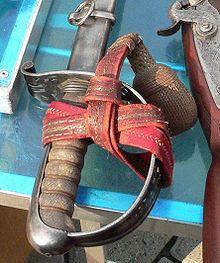Portepee
The portepee ( French porte-épée , degentrage ' ,' Degengangk '), also known as a fist strap and especially in Switzerland also known as a batting strap, was originally a loop looped around the handle and bow of a cutting weapon and around the fighter's wrist to prevent the weapon from falling should prevent in combat. A badge of rank for officers and sergeants later developed from it.
In the Bundeswehr the sergeant ranks are still called NCOs with portepee (UmP). In the Navy , the term "PUO" (Portepee NCOs) is used for boat people .
history
The term, which can be traced back to French as early as the 16th century, initially referred to all handle loops for side arms ( epee , saber , pallasch , sword ), regardless of whether they were carried by men, non-commissioned officers or officers. The portepee, especially for mounted fighters, was intended on the one hand to prevent the weapon from falling out of the hand on the ground during combat, and on the other hand to enable a firearm ( pistol ) to be used without having to stick the blade in the sheath.
Portepees had a tassel where the leather or fabric straps were sewn together to form a loop . This tassel was made of wool for the lower ranks. Officers had tassels made of metal spun early on, which no longer ended with fraying, but had a firm nut-like or acorn-like end. The straps of the soldiers of the cavalry associations and the horsemen artillery kept the German name of thumb strap , with the other soldiers called tassel .
In the imperial army , the Reichswehr and the Wehrmacht , the knuckle strap with tassels in different colors served as an ornament on the side gun and a distinguishing feature of military units .
The original knuckle of knuckle of officers and NCOs from Sergeant upwards was in most armies with silver or gold braid and was called portepee .
As early as the 18th century, the portepee in Prussia was mainly used as an officer's badge, as there were no badges of rank and sashes and ring collars were only worn on duty. With the portepee, the officer was also entitled to the honorary certificates due to his rank outside of duty . The sergeants of the Prussian army were granted portepee from 1741, initially in parts of the guard, and generally from 1789 onwards. The badge was initially worn on the team saber, and since 1822 on the officer's sword, which was to be attached to the team's paddock. The rank of Vice Sergeant , introduced in 1846/1873, was also allowed to do portepee. Since then there is a rank group of NCOs with (or without) portepee. In addition, uniformed state officials of the higher service were allowed to wear the portepee.
The portepee was no longer used by the Bundeswehr or NVA after the Second World War . The metal web of the portepees can still be found today in the uniforms of the Bundeswehr as the collar and epaulette piping of the officers (generals in gold, other officers in silver). NCOs with portepee have an old gold collar piping that is reminiscent of the metal web of portepees. In the Austrian Armed Forces the portepee is still worn with the parade uniform .
Structure and colors
The portepee consists of ribbon, slider, stem, wreath and tassel . The tassels for NCOs in the Prussian Army were in the shape of an acorn . In the Wehrmacht only portepees in the form of acorns were issued, these portepees were silver.
The portepees of the Austrian officers have an open tassel and are gold-colored.
The impact tape in the Swiss Army is red. A white tassel is added for officers and a red and white tassel for senior NCOs.
literature
- Max Hein: The Little Book of the German Army A manual and reference book for instruction on the German war power. Processed according to the latest regulations. Lipsius & Tischer, Kiel [a. a.] 1901 (Reprint, Weltbild Verlag GmbH, Augsburg 1998, ISBN 3-8289-0271-5 ).
- Friedrich Altrichter: The reserve officer. A manual for the officer and officer cadet for the license of all weapons. 6th revised edition. ES Mittler & Sohn, Berlin 1938.



